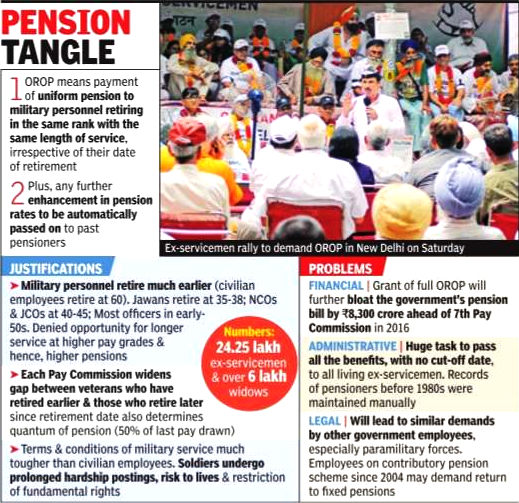ForumIAS announcing GS Foundation Program for UPSC CSE 2025-26 from 19 April. Click Here for more information.
ForumIAS Answer Writing Focus Group (AWFG) for Mains 2024 commencing from 24th June 2024. The Entrance Test for the program will be held on 28th April 2024 at 9 AM. To know more about the program visit: https://forumias.com/blog/awfg2024
Contents
What is the News?
The Supreme Court upheld the manner in which the government had introduced the “One Rank One Pension” scheme in defence forces.
What is One Rank One Pension(OROP)?
One Rank, One Pension rule means that retired soldiers of the same rank and length of service will receive the same pension, regardless of when they retire.
Roughly translated, a sepoy who retired in 1995 with 20 years of service should get the same pension as a sepoy who retired in 2010 after 20 years of service.
Background of OROP
From 1950 to 1973, there was a concept known as the Standard Rate of Pension, which was similar to OROP.
In 1974, when the 3rd Pay Commission came into force, certain changes were effected in terms of weightage, additional years of notion service, etc regarding pensions. In 1986, the 4th Pay Commission’s report brought further changes.
What ultimately happened was that the benefits of the successive pay commissions were not passed to servicemen who had retired earlier. Pensions were deferred for those who had retired at the same rank, with the same years of service, but years apart.
Demand of OROP
Ex-servicemen demanded OROP to correct the discrepancy. Over the decades, several committees looked into it.
The Brig K P Singh Deo committee in 1983 recommended a system similar to the Standard Rate of Pension, as did Parliament’s standing committees on defence.
In 2011, the Rajya Sabha Committee on Petitions (Koshyari Committee) recommended the implementation of OROP
In 2015, the government notified the current OROP scheme and it was made applicable from July 1, 2014.
Challenge in Supreme Court against this OROP Scheme
A petition was filed in the Supreme Court challenging the current OROP Scheme implemented since 2015.
The petitioner argued that in the course of implementation, the OROP principle has been replaced by ‘one rank multiple pensions’ for persons with the same length of service.
This is because the current OROP scheme says that equalization of pension would happen periodically every five years.
However, the equalization of pension should be automatic, that is, whenever there is disparity. The gap of five years would leave them at a great disadvantage.
What has the Supreme Court said?
The Supreme Court upheld the manner in which the government had introduced the “One Rank One Pension” scheme in defence forces. The court said that it did not come across any “constitutional infirmity” in the manner in which OROP was being implemented.
Source: This post is based on the article “Explained: The rank-pension case” published in Indian Express on 17th Mar 2022.





